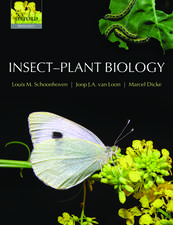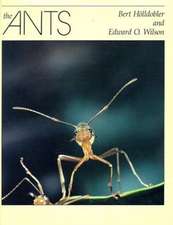Defensive (anti-herbivory) Coloration in Land Plants
Autor Simcha Lev-Yadunen Limba Engleză Hardback – 2 noi 2016
| Toate formatele și edițiile | Preț | Express |
|---|---|---|
| Paperback (1) | 950.03 lei 6-8 săpt. | |
| Springer International Publishing – 22 iun 2018 | 950.03 lei 6-8 săpt. | |
| Hardback (1) | 956.18 lei 6-8 săpt. | |
| Springer International Publishing – 2 noi 2016 | 956.18 lei 6-8 săpt. |
Preț: 956.18 lei
Preț vechi: 1166.08 lei
-18% Nou
Puncte Express: 1434
Preț estimativ în valută:
182.99€ • 198.70$ • 153.71£
182.99€ • 198.70$ • 153.71£
Carte tipărită la comandă
Livrare economică 23 aprilie-07 mai
Preluare comenzi: 021 569.72.76
Specificații
ISBN-13: 9783319420943
ISBN-10: 3319420941
Pagini: 360
Ilustrații: XXIII, 385 p. 169 illus. in color.
Dimensiuni: 155 x 235 x 24 mm
Greutate: 0.75 kg
Ediția:1st ed. 2016
Editura: Springer International Publishing
Colecția Springer
Locul publicării:Cham, Switzerland
ISBN-10: 3319420941
Pagini: 360
Ilustrații: XXIII, 385 p. 169 illus. in color.
Dimensiuni: 155 x 235 x 24 mm
Greutate: 0.75 kg
Ediția:1st ed. 2016
Editura: Springer International Publishing
Colecția Springer
Locul publicării:Cham, Switzerland
Cuprins
Part I - General background
Chapter 1. Introduction
Chapter 2. Plants are not sitting ducks waiting for herbivores to eat them
Chapter 3. The many defensive mechanisms of plants
Chapter 4. No defense is perfect and defense is always relative
Chapter 5. Operating under stress and fear in the military as a lesson concerning difficulties for herbivory in nature. Factors that lower the need for perfect defensive mechanisms including mimicry
Chapter 6. Evaluating risk: the problematic and even erroneous common view of "no damage or no attack equals no risk"
Chapter 7. Partial descriptions of color patterns in floras and handbooks has consequences on the study of plant coloration biology
Chapter 8. Animal color vision
Chapter 9. The nature of signals
Chapter 10. White as a visual signal
Chapter 11. Visual signaling by plants to animals via color
Chapter 12. Müllerian and Batesian mimics are extended phenotypes
Part II - Gentle defenses
Chapter 13. Camouflage
Chapter 14. Seed camouflage
Chapter 15. Pod and seed camouflage in the genus Pisum
Chapter 16. Defensive functions of white coloration in coastal and dune plants
Chapter 17. Gloger's rule in plants: the species and ecosystem levels
Chapter 18. Defensive masquerade by plants
Chapter 19. Potential defense from herbivory by dazzle effects and trickery coloration of variegated leaves
Chapter 20. Plants undermine herbirorous insect camouflage
Chapter 21. Delayed greening
Chapter 22. Red/purple leaf margin coloration: potential defensive functions
Part III - Aggressive defenses
Chapter 23. Aposematism
Chapter 24. Olfactory aposematism
Chapter 25. The anecdotal history of discussing plant aposematic coloration
Chapter 26. Aposematic coloration in thorny, spiny and prickly plants
Chapter 27. Fearful symmetry in aposematic spiny plants
Chapter 28. Color changes in old aposematic thorns, spines, and prickles
Chapter 29. Pathogenic bacteria and fungi on thorns, spines and prickles
Chapter 30. Aposematism in plants with silica needles and raphids made of calcium oxalate
Chapter 31. Müllerian and Batesian mimicry rings of aposematic thorny, spiny and toxic plants
Chapter 32. Batesian mimicry and automimicry of aposematic thorns, spines and pricklesChapter 33. Additional cases of defensive visual Batesian mimicry among plants
Chapter 34. When may green plants be aposematic?
Chapter 35. Spiny east Mediterranean plant species flower later and in a drier season than non-spiny species
Chapter 36. Biochemical evidence of convergent evolution of aposematic coloration in thorny, spiny and prickly plants
Chapter 37. Aposematic coloration in poisonous flowers, fruits and seeds
Chapter 38. Aposematic trichomes: probably an overlooked common phenomenon
Chapter 39. Why is latex usually white and only sometimes yellow, orange or red? Simultaneous visual and chemical plant defense
Chapter 40. Visual defenses basically operating by various mechanisms that have an aposematic component
Chapter 41. Plant aposematism involving fungi
Chapter 42. Do plants use visual and olfactory carrion-based aposematism to deter herbivores?
Chapter 43. Gall aposematism
Chapter 44. Experimental evidence for plant aposematism
Part IV - Masterpieces of visual defense
Chapter 45. The complicated enigma of red and yellow autumn leaves
Chapter 46. Leaf color variability
Chapter 47. What do red and yellow autumn leaves signal for sure?
Chapter 48. The second generation of hypotheses about colorful autumn leaves
Chapter 49. The shared and separate roles of aposematic (warning) coloration and the co-evolution hypothesis in defending autumn leaves
Chapter 50. Spring versus autumn or young versus old leaf colors: evidence for different selective agents and evolution in various species and floras
Chapter 51. How red is the red autumn leaf herring and did it lose its red color?
Chapter 52. Defensive animal and animal action mimicry by plants
Chapter 53. Caterpillar and other herbivore feeding damage mimicry as defense
Chapter 54. Tunneling damage mimicry
Chapter 55. Butterfly egg mimicry
Chapter 56. Caterpillar mimicry
Chapter 57. Aphid mimicry
Chapter 58. Ant mimicry
Chapter 59. Beetle mimicry
Chapter 60. Spider web mimicry
Chapter 61. Defensive bee and wasp mimicry by orchid flowers
Chapter 62. Gall midge mimicry
Chapter 63. Arthropod wing movement mimicry
Chapter 64. "Eye spot" mimicry
Chapter 65. Snake mimicry
Chapter 66. Visual and olfactory feces and carrion mimicry
Chapter 67. Extended phenotype
Chapter 68. A general perspective of defensive animal mimicry by plants
Chapter 69. Currently temporary final words
Notă biografică
Prof. Simcha Lev-Yadun
Department of Biology and Environment,
Faculty of Natural Sciences,
University of Haifa- Oranim,
Tivon 36006
Israel
Major Research Interests:
The beginning of agriculture: The biology and genetics of plant domestication.
The ecology and evolution of defensive vegetative coloration in plants.
Developmental processes in plants: meristematic activity and its ecology and regulation, fate of apical meristems, homeosis, pattern formation.
Arabidopsis thaliana as a model for the biology of trees.
Biology and ecology of trees and other woody plants.
Palaeoecology: Dendrochronology, identification of botanical material from archaeological excavations, reconstruction of palaeoenvironments.
Textul de pe ultima copertă
This book presents visual plant defenses (camouflage, mimicry and aposematism via coloration, morphology and even movement) against herbivores. It is mainly an ideological monograph, a manifesto representing my current understanding on defensive plant coloration and related issues. The book is not the final word in anything, but rather the beginning of many things. It aims to establish visual anti-herbivory defense as an integral organ of botany, or plant science as it is commonly called today. I think that like in animals, many types of plant coloration can be explained by selection associated with the sensory/cognitive systems of herbivores and predators to reduce herbivory. It is intended to intrigue and stimulate students of botany/plant science and plant/animal interactions for a very long time. This book is tailored to a readership of biologists and naturalists of all kinds and levels, and more specifically for botanists, ecologists, evolutionists and to those interested in plant/animal interactions. It is written from the point of view of a naturalist, ecologist and evolutionary biologist that I hold, considering natural selection as the main although not the only drive for evolution. According to this perspective, factors such as chance, founder effects, genetic drift and various stochastic processes that may and do influence characters found in specific genotypes, are not comparable in their power and influence to the common outcomes of natural selection, especially manifested when very many species belonging to different plant families, with very different and separate evolutionary histories, arrive at the same adaptation, something that characterizes many of the visual patterns and proposed adaptations described and discussed in this book. Many of the discussed visual defensive mechanisms are aimed at operating before the plants are damaged, i.e., to be their first line of defense. In this respect, I think that the name of the book by Ruxton et al. (2004) "Avoiding Attack" is an excellent phrase for the assembly of the best types of defensive tactics. While discussing anti-herbivory, I do remember, study and teach physiological/developmental aspects of some of the discussed coloration patterns, and I am fully aware of the simultaneous and diverse functions of many plant characters in addition to defense.
Caracteristici
This is the first and only book focusing on defensive plant coloration (aposematism, camouflage, mimicry and other types of defensive visual signalling and deception demonstrated by 170 colour photos). It illuminates many overlooked aspects of plant evolution and ecology
This book is aimed to provoke and stimulate students and scientists of plant-animal interactions to further pursue visual plant defences against herbivores. Such mechanisms can allow developing greener agricultural practices
This book outlines the basics of visual plant defences against herbivorous animals in order to establish this neglected area of plant evolution and ecology as an ordered branch of plant biology
This book is aimed to provoke and stimulate students and scientists of plant-animal interactions to further pursue visual plant defences against herbivores. Such mechanisms can allow developing greener agricultural practices
This book outlines the basics of visual plant defences against herbivorous animals in order to establish this neglected area of plant evolution and ecology as an ordered branch of plant biology












